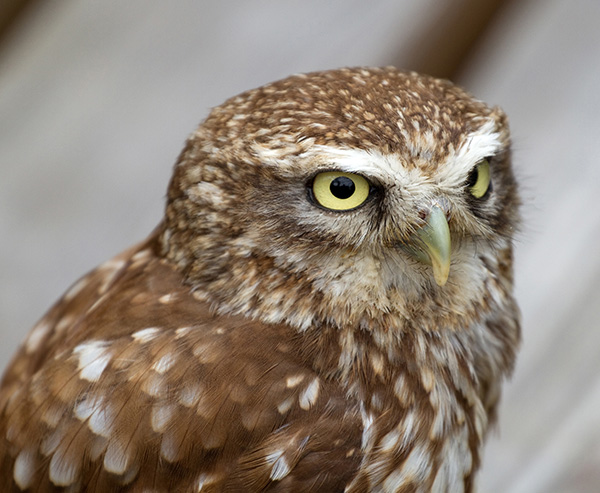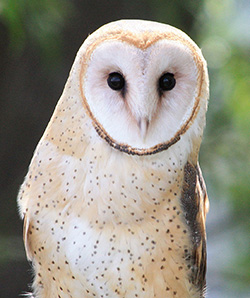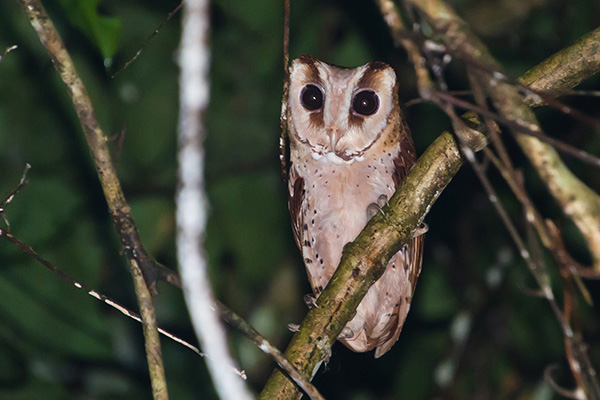
Brown owls have binocular-like vision, allowing them to judge distances with absolute precision.
SHAKESPEARE, in his play ‘Love Labours Lost’ at the end of Act 5, Scene 2, wrote, “Tu-whit, Tu-who – a merry note while greasy Joan doth keel (cool) the pot …”
A merry note indeed, as very recently in daylight I saw an owl sitting on a tree branch eyeing a pheasant as it strutted along the grass below. Fortunately for the pheasant, my dog chased it away and the owl took off in a different direction.
I have seen the same owl roosting, at dusk, on telegraph poles near my house or, later at night, it has swooped low over my head as I have taken household rubbish to the outside dust bin. It is a Brown (Tawny) owl. Very occasionally I see a Barn Owl but much less frequently than 20 years ago. Besides these two British owl types, I feel privileged to have seen two species of Malaysian owl.
Brown owl
A male brown owl calls ‘twit-to-woo’ and a female owl responds with ‘kwick-kwick’. Unlike other large-winged birds they are silent in flight because their feathers have soft tips, which break up the air flow over them. Their large penetrating eyes have binocular-like vision, allowing them to judge distances with absolute precision with inbuilt night vision. They are truly remarkable birds with swivel heads, which can turn through 270 degrees to look directly behind them. This is because of special swivel vertebrae in their necks.
Only 38 centimetres in body length, they prey mainly at dawn or dusk on field mice and voles or anything else, which they take a fancy to. Seizing their prey in their powerful talons, they swallow it whole. Indigestible parts to include fur and bones, they regurgitate in the form of pellets.
Fearlessly, they guard their nests in hollow trees and have been known to attack animal intruders and even humans. Laying between two and four white eggs as early as March, two months after incubation the owlets will fly. Interestingly, there have been no sightings of brown owls on the remoter Scottish islands or in Ireland.

The barn owl has a distinctive heart-shaped whitish head.
Barn owl
This slightly smaller owl, whilst widely distributed throughout the British Isles, is far less numerous than the brown owl. With its distinctive heart-shaped whitish head and breast and fawn patterned back, this species has decreased due to farmers’ modifications of their barns and the covering of church belfries, favoured nesting places, with wire mesh.
Like all owl species, and unlike falcons and hawks, they glide down on their prey in a totally silent motion.
When they are above their prey, they hit the animal with their feet with such a massive force that they stun it.
However, the ever-increasing use by farmers of pesticides has also been a contributory factor to the decline in their numbers. Such pesticides accumulate in the bodies of small animals and are thus passed up the food chain, with owls amassing huge quantities of these chemicals.
With its ghostly colourings and shape, combined with a moaning cry, it is reassuring in my part of the United Kingdom that local farmers have encouraged this owl to breed in old-fashioned wooden, rather than in metal-prefabricated, barns. Their nests often take the form of a pile of regurgitated pellets on which they lay their eggs in April or May. The hatched owlets fly within four months and in a warm summer two broods may be produced.
Britain only houses six species of owl, whereas Malaysia enviably hosts nine species.
Bornean owl
Officially known as the Oriental Bay Owl, this owl has haunted my mind for many a year. It was one afternoon in 1999 that I lost one of my rubber boots whilst trying to photograph this bird in a swamp alongside the Kinabatangan River in eastern Sabah.
My struggle to retrieve my boot was much to the owl’s amusement as it flew off, occasioned by the hilarious laughter from my family who, at the time, did not appreciate my predicament. My photo was blurred and I lost my boot as it was sucked into the mire.
This owl was perched only a metre above the swamp floor and when it took off I heard its distinctive hoot of ‘kleek-kleek-kleek’. Facially, and in its plumage colourings, this bay owl looked very similar to the UK barn owl.
The females of this species of bay owl are much larger than the males and they breed in hollows in tree trunks. Surviving on a feast of rats, mice, bats, small birds, frogs and lizards, they live close to water. As with most breeds of owl, the mating male acquires food by day or night to feed the three or four owlets.
Robert Shelford (a former Curator of Sarawak Museum from 1897-1905) records in his book, ‘A Naturalist in Borneo’, detailed observations of his oriental bay owl, which he kept in captivity in Kuching. This is probably the first documented account of this owl. When Shelford first received this young bird, its feathers were white and narrowly barbed with brown. Later as it gradually aged, the feathers changed to become dark brown with bands of reddish brown.
Shelford explained this phenomenon as “the spreading of pigment along the barbules of the original features” with the dark colourings encroaching into the formerly white areas of its plumage. His detailed descriptions of his owl’s sounds and its digestive habits make excellent reading, together with superb monochrome photos of his owl.
Buffy fish owl
This species of owl is also known as Bubo ketupu or Ketupa ketupu. Last year, on a leisurely walk alongside a river mouth in Batu Pahat, Johor, I thought what looked like an eagle swooped low over my head, but it had rounded wings. Only by perching on a nearby mangrove tree did I have a real chance to see its penetrating eyes transfixed on me.
It was also yellowish-brown in colour. Its morose look reminded me of tales that I had heard about such an owl in Sabah, for there the bird is regarded as an ill-omen.
It was its ears, which lent it this dolorous look as, unlike other owls with upright pointed ears, the ears of the buffy fish owl hang down either side of its head.
Most owl species tend to have their beaks well below their eyes, but this species has a beak in an almost human nose-like position extending upwards between its eyes.
My fish owl swept down to the shallows of the river, scooped up a fish in its talons and disappeared into the darker areas of the nearby mangrove swamp.
Further research told me that this breed of owl is frequently seen near habitation, for alongside me was a fishing village with dozens of feral pigeons on the roofs of houses and a nearby school.
Besides, obviously, fish, the buffy fish owl thrives on small crabs, crayfish, snakes and toads, with a further diet of insects, mice, rats and fruit bats. The female lays one single egg in an abandoned nest of another bird. The incubation period is only a month and within six weeks the owlet is fully fledged. Some local people there told me that they have seen these owls scoop down to catch fish in their ornamental garden ponds.
I only wish I was a wiser old owl and knew more about these birds, for after all nature is a university in its own right.

Oriental bay owls live close to water, where they survive on a feast of rats, mice, bats, small birds, frogs and lizards.
